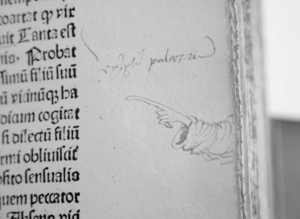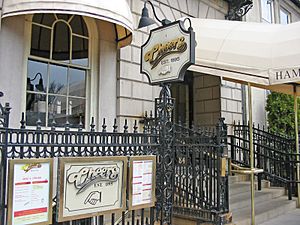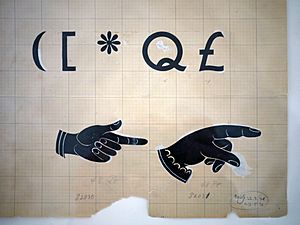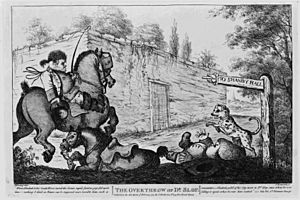Manicule facts for kids
| This article contains special characters. Without proper rendering support, you may see question marks, boxes, or other symbols. |
| ☚ ☞ ☟ | |
|---|---|
|
Manicule
|
|
| In Unicode | Error using : Input "261A" is not a hexadecimal value. |
The manicule, ☛, is a special symbol that looks like a hand with its index finger pointing. Think of it as a little hand symbol!
Long ago, people used manicules in handwritten notes to point out important parts. Later, when books were printed, this symbol was used to grab the reader's attention. Even though it was very popular once, you don't see it much today. Sometimes, it's used as a fun, old-fashioned design.
Contents
What's in a Name?
For a long time, this pointing hand symbol had many different names. William H. Sherman, who studied the manicule a lot, used the name manicule. This comes from the Latin word manicula, which means "little hand."
People also called it:
- hand
- pointing hand
- pointer
- index
- printer's fist
Some names, like pilcrow, were actually wrong. A pilcrow (¶) is a different symbol used to mark paragraphs.
History of the Manicule
Handwritten Manicules
The manicule started with people who copied books by hand, called scribes, during the Middle Ages and Renaissance. They would draw these little hands in the margins of manuscripts (handwritten books). This helped them mark corrections or important notes.
One of the earliest books known to have manicules is the Domesday Book from 1086. The manicules were used for notes in the margins. We don't know exactly when these notes were added, but they could be from later than the 11th century.
Manicules first appeared in handwritten books in Spain in the 1100s. They became very common in Italy in the 1300s and 1400s. Some were fancy with shading and cuffs, like tiny artworks. Others were very simple, just a few quick lines to show a pointing hand.
Even after the printing press became popular around 1450, people still drew manicules by hand. They used them to add notes to printed books. But by the 1800s, this practice became less common.
Manicules in Print
Early printers started using type (metal letters) to make manicules in their books. One of the first printed books with a manicule was in 1479.
At first, printed manicules appeared in the main text of a book. They would point outwards to notes printed in the margin. Later, in the 1500s, manicules became a decorative design. You could find them on the title pages of books, along with other symbols like the fleuron (❦), which looks like a fancy flower.
The manicule became very popular in the 1800s, especially in advertisements. They also started to look more different, with bigger and more detailed hands. You could even see them on signs, like fingerposts (road signs). Some of these signs had actual three-dimensional pointing hands! The United States Postal Service even used a pointing hand on its "Return to Sender" stamp.
However, the manicule's popularity began to fade by the late 1800s. Maybe it was used too much in advertising, making it less special. By the 1890s, it was rarely seen unless someone wanted to be funny or old-fashioned. Some experts believe that as the symbols became more standard, they lost their unique, personal touch.
How Manicules Were Used
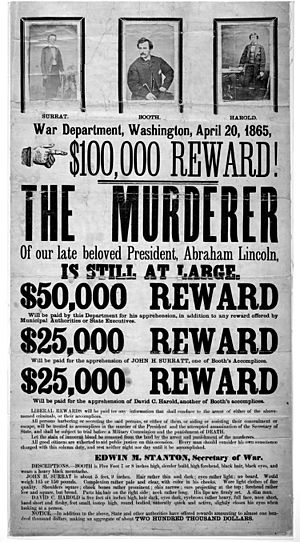
The main way a pointing hand was used was like a bullet point. It directed the reader's eye to important text. It meant something like "attention" or "note this." Both people writing notes and printers used it this way.
Even in its early days, the manicule was used to highlight specific text. This could be a title, a new piece of text, or an important sentence. Sometimes, a whole row of manicules would be used to draw attention! Other symbols, like flower marks or asterisks, were used for similar reasons.
Less often, in older times, the pointing hand acted as a section divider. It could also sometimes mark the start of a new paragraph.
In some encyclopedias, you might see it used to tell you to look at other articles, like this: ☞ other articles. Magazines and comic books sometimes use it to show that a story continues on the next page.
In modern printing, it was a standard symbol for notes. An American dictionary from 1894 listed it as the seventh symbol in a standard list of footnote markers.
The science fiction writer Kurt Vonnegut used the manicule in his novel Breakfast of Champions. He put the symbol at the start of every paragraph. This made each paragraph feel separate, which helped create a "stream of consciousness" style in the book.
The Pointing Hand as a Computer Cursor
An upward-pointing hand is often used as a mouse cursor on computers. You might see it in programs like Adobe Acrobat or Photoshop. It shows you that you can click on or move an object.
The first computer to use this kind of cursor was probably the Xerox Star. Many web browsers use an upward-pointing hand cursor to show that something is a clickable hyperlink. This means you can click on it to go to another page or place.
Some video games from the 1980s and 90s, especially text-based adventure games, also used these pointing hand cursors.
Manicules in Unicode
Unicode is a system that helps computers show text and symbols from different languages. In 1991, Unicode added six "pointing index" characters. These are the basic pointing hands you might see.
Later, in 2010, Unicode added several emoji pointing hands. These are the colorful hand emojis you use on your phone! More pointing hand symbols were added in 2014 and 2020, giving us even more ways to show a pointing hand on our devices.
See also
 In Spanish: Manecilla (signo) para niños
In Spanish: Manecilla (signo) para niños


